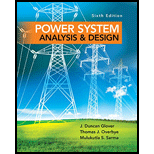
Concept explainers
A small manufacturing plant is located 2 km down a transmission line, which has a series reactance of
Trending nowThis is a popular solution!

Chapter 2 Solutions
Power System Analysis and Design (MindTap Course List)
- Develop a small-scale equivalent transmission line pi model (per phase) of the transmission lines with the specification given in table 1. The conductors are placed with a flat horizontal spacing of 7.25 meters. Consider that the load connected against the line 125MW at 0.85 lagging power factor. You are required to develop an equivalent model for a maximum 220V (RMS) sending and receiving end voltage and a maximum of 5A load current. Sr. NTDC Transmission Line Length Conductor No. Туре 220 kV DG Khan-Loralai Transmission Line (227 km) 227km Pheasant TABLE AJ Electrical characteristics of bare aluminum conductors steel-relnforced (ACSR)+ Reniertance Reactance per conductor 1-ft apacing. 60 Ha Ae, 60 Ha Capaitive Aluminum ares, emil Layers of Outaide aluminum diameter, in a/1,000 ft soC, D/ml GMR Induetive Stranding AL/8t De, 20°C. 20C, a/mi Code word D. t Ma-mi Waswing Partridge Ostrieh Merlin Linnet Oriole Chickndee Ibin Pelienn Flicker Hawk 266,800 206,800 300,000 336, 400 336.400…arrow_forwardThe figure shows a 500-kV (line-to-line voltage) transmission line linking two systems. The theoretical maximum power that can be transferred from System A to System B is 5,000 MW, which occurs when the power angle 8 = 90°. The line current is then proportional to (VA - VB) The reactive power losses (Mvar) in the transmission line during this transfer would be most nearly: Wond O A. 1,667 O B.. 3,333 O C. 5,000 O D. 10,000 Know EQUIVALENT SYSTEM A VA= 500 28 KV m XL = 50 Ω EQUIVALENT SYSTEM B VB = 500 40⁰ kV Oarrow_forwardParagraph Styles The power factor must be close to in the transmission lines will be reduced To insure that losses D(Ctrl) -arrow_forward
- Complete the sentence The power factor must be close to ……………. To insure that losses in the transmission lines will be reducedarrow_forward1) A 60-Hz, ...-km, three-phase overhead transmission line has a series impedance z = 0.8431L79.04 ohm/km and a shunt admittance y = 5.105 × 106 L90 S/km. The load at the receiving end is 125 MW at unity power factor and at 215 KVLL. Determine the voltage, current, real and reactive power at the sending end and the percent voltage regulation of the line for nominal pi network. (Please determine the length of the transmission line within the specified limits: 150-220 km. By considering the length value you determined yourself, solve the question.)arrow_forwardSelect the base voltages for one section and calculate the base voltages for the rest of the sections. Remember that the voltages given are line-line. Calculate the current and impedance for all sections of the System. Assume a base complex power of 100 MVA.arrow_forward
- Tam responsible for any violations with regard to this. A load of 135 MW at a power factor of 0.65 lagging can be delivered by a 3-phase transmission line. The voltage at the receiving end is to be maintained at 54 kV and the loss in the of transmission is 6 % of the power delivered. (Consider the line to be a short transmission line) Find ion Single phase Power delivered Per phase voltage snt fleiarrow_forwardA surge of 100 kV travels along an overhead line towards its junction with a cable. The surge impedance for the overhead line and cable are 400 ohms and 50 ohms respectively. The magnitude of the surge transmitted through the cable is ?arrow_forwardCalculate the capacitance of a single phase 50 Hz overhead line 40 km long consisting of two parallel wires each 5 mm in diameter, 1.5 metres apart, taking the effect of ground into consideration. The height of the conductors above ground is 7 metres. Derive any formula used. [A.P.S. Univ. Electric Power Generation, Transmission and Distribution 1978) [Ans. 0.174 pF] Aarrow_forward
- The steady-state voltage drop between the load and the sending end of the line seen in (Figure 1) is excessive Suppose that V-4950/0° V (rms). A capacitor is placed in parallel with the 192 kVA load and is adjusted until the steady-state voltage at the sending end of the line has the same magnitude as the voltage at the load end, that is, 4950 V (rms). The 192 kVA load is operating at a power factor of 0.8 lag. Part A Calculate the size of the capacitor in microfarads if the circuit is operating at 60 Hz. In selecting the capacitance, use the value that results in the lowest possible power loss in the line. Express your answer in microfarads to three significant figures. ▸ View Available Hint(s) Figure 1 of 1 202 1100 192 kVA 0.8 lag ΜΕ ΑΣΦ. 11 vec C= 22.8 Submit Previous Answers Incorrect; Try Again; 5 attempts remaining Provide Feedback ? Farrow_forwardA 220 kV, three phase transmission line is 50 km long. The resistance per phase is r 2 per km and the inductance per phase is L mH per km. The shunt capacitance is negligible. If the line supplies a three-phase load of 229 MVA at 0.8 power factor lagging at 220 kV with an efficiency of 97.13% and a voltage regulation of 4.7581%. Use the short line model to find the line resistance and inductance of the line.arrow_forwardCalculate the impedance ?? for the maximum average power transfer in the circuit shown in Figure 3.and ??Find the value of the maximum average power transferred to?arrow_forward
 Power System Analysis and Design (MindTap Course ...Electrical EngineeringISBN:9781305632134Author:J. Duncan Glover, Thomas Overbye, Mulukutla S. SarmaPublisher:Cengage Learning
Power System Analysis and Design (MindTap Course ...Electrical EngineeringISBN:9781305632134Author:J. Duncan Glover, Thomas Overbye, Mulukutla S. SarmaPublisher:Cengage Learning
